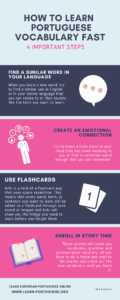
Learning a new language like Portuguese can be both exciting and challenging. One of the most effective ways to build your vocabulary is by using flashcards. Flashcards are a simple yet powerful tool that can help you memorize words, phrases, and even grammar rules. They allow you to focus on active recall, which is essential for long-term retention. In this article, we’ll explore how to use flashcards effectively to learn Portuguese vocabulary, provide tips for creating and organizing them, and recommend some tools to make the process easier.
Why Use Flashcards for Learning Portuguese?
Flashcards are a proven method for language learning because they engage your brain in active recall. This means you’re not just passively reading or listening to words—you’re actively trying to remember them. Here are some reasons why flashcards are particularly effective for learning Portuguese:
- Repetition and Retention: Flashcards use spaced repetition, a technique that helps you review words at increasing intervals to reinforce memory.
- Customizable Content: You can create flashcards tailored to your learning goals, focusing on specific topics like travel, food, or verbs.
- Portable and Convenient: Whether you use physical cards or digital apps, flashcards are easy to carry and use anywhere.
- Engages Multiple Senses: Writing, reading, and speaking the words on your flashcards helps reinforce learning through multiple sensory channels.
How to Create Effective Flashcards for Portuguese Vocabulary
Creating effective flashcards is key to maximizing their benefits. Here’s how to do it:
1. Focus on One Word or Phrase Per Card
Each flashcard should focus on a single word or phrase. For example, one side of the card could have the Portuguese word “cachorro” (dog), and the other side could have the English translation. Avoid cramming too much information onto one card, as this can overwhelm you.
2. Include Context
Learning words in isolation can be difficult, so try to include context. For example, instead of just writing “comer” (to eat), you could write a sentence like “Eu gosto de comer pizza” (I like to eat pizza). This helps you understand how the word is used in real-life situations.
3. Use Images
Adding images to your flashcards can make them more engaging and help you associate words with visual cues. For example, for the word “gato” (cat), you could include a picture of a cat. This is especially helpful for visual learners.
4. Incorporate Pronunciation
Portuguese pronunciation can be tricky, so include the phonetic spelling or a link to an audio file on your flashcards. For example, for the word “saudade” (a deep emotional state of longing), you could write “sow-DAH-jee” to help you pronounce it correctly.
5. Color Code Your Cards
Organize your flashcards by categories using colors. For example:
- Green for verbs.
- Blue for nouns.
- Yellow for adjectives.
This makes it easier to focus on specific areas of vocabulary.
How to Use Flashcards Effectively
Once you’ve created your flashcards, it’s important to use them in a way that maximizes learning. Here are some tips:
1. Practice Daily
Consistency is key when learning a language. Dedicate at least 10–15 minutes a day to reviewing your flashcards. Regular practice helps reinforce your memory and ensures you don’t forget what you’ve learned.
2. Use Spaced Repetition
Spaced repetition is a technique that involves reviewing flashcards at increasing intervals. Apps like Anki and Quizlet use this method to help you focus on words you struggle with while spacing out reviews of words you already know.
3. Say the Words Out Loud
When reviewing your flashcards, say the words and sentences out loud. This helps improve your pronunciation and reinforces your memory through auditory learning.
4. Test Yourself
Instead of flipping the card immediately, try to recall the answer first. This active recall strengthens your memory and helps you retain the information longer.
5. Mix Up the Order
Avoid reviewing your flashcards in the same order every time. Shuffle them to ensure you’re not just memorizing the sequence but actually learning the words.
6. Use Both Directions
Practice both sides of the flashcard. For example, look at the Portuguese word and recall the English translation, and then reverse it by looking at the English word and recalling the Portuguese translation.
Digital vs. Physical Flashcards
Both digital and physical flashcards have their advantages. Here’s a quick comparison to help you decide which is best for you:
Physical Flashcards
- Pros: Writing by hand helps with memory retention, and they don’t require a device or internet connection.
- Cons: They can be bulky to carry around and harder to organize.
Digital Flashcards
- Pros: Apps like Anki, Quizlet, and Memrise offer features like spaced repetition, audio pronunciation, and the ability to add images. They’re portable and easy to update.
- Cons: They require a device and may distract you with notifications.
For most learners, a combination of both works best. You can use physical flashcards for writing practice and digital ones for on-the-go learning.
Recommended Flashcard Apps for Learning Portuguese
If you prefer digital flashcards, here are some of the best apps to consider:
- Anki: Known for its powerful spaced repetition algorithm, Anki is a favorite among language learners. You can create your own decks or download pre-made Portuguese decks.
- Quizlet: Quizlet offers a user-friendly interface and features like games and quizzes to make learning fun.
- Memrise: Memrise combines flashcards with videos of native speakers, helping you learn vocabulary and pronunciation simultaneously.
- Brainscape: Brainscape uses a confidence-based repetition system, allowing you to focus on words you find most challenging.
Conclusion
Flashcards are a simple yet highly effective tool for learning Portuguese vocabulary. By creating well-organized and engaging flashcards, practicing daily, and using techniques like spaced repetition and active recall, you can significantly improve your vocabulary retention. Whether you choose physical cards, digital apps, or a combination of both, the key is consistency and making the process enjoyable. With dedication and the right approach, you’ll be speaking Portuguese confidently in no time.


